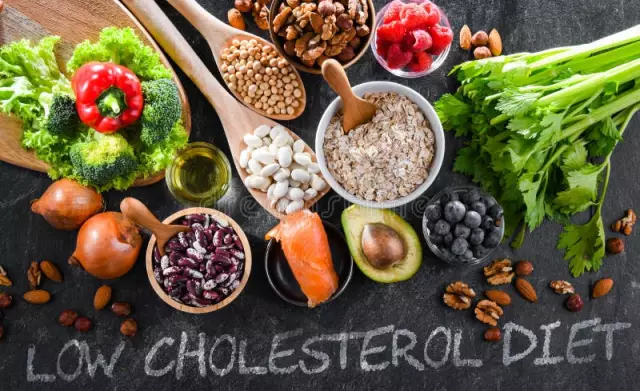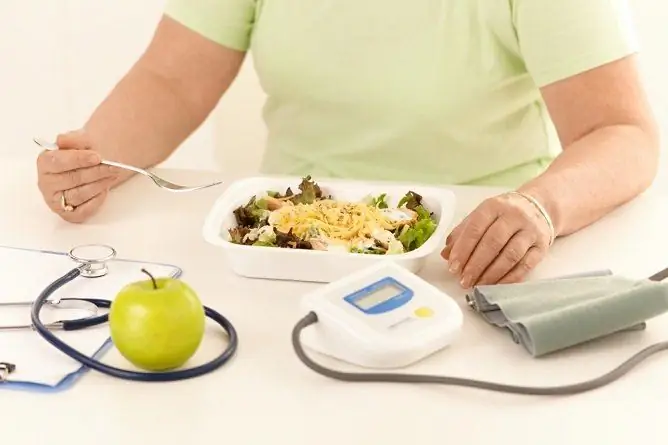- Author Rachel Wainwright [email protected].
- Public 2023-12-15 07:39.
- Last modified 2025-11-02 20:14.
Acidic gastritis
The content of the article:
- Causes and risk factors
- Symptoms of gastritis with high acidity
- Diagnostics
- Treatment of gastritis with high acidity
- Diet for gastritis with high acidity
- Potential consequences and complications
- Forecast
- Prevention
Gastritis with high acidity (hyperacid gastritis) is an inflammatory lesion of the gastric mucosa, accompanied by an increase in the secretory activity of parietal cells. The disease can be both acute and chronic.

Heartburn is a common symptom of acidic gastritis.
Acidic gastritis is often seen in young people, adolescents and children. This is largely due to improperly formed eating habits (snacks on the go, irregular, unbalanced meals, abuse of fast food and snacks).
Many patients consider this disease to be frivolous and self-medicate without seeking medical help. The unsystematic use of antacids, folk remedies that lower the acidity of gastric juice, ultimately leads to atrophy of the gastric mucosa, the development of gastric ulcer and duodenal ulcer.
Causes and risk factors
The main cause of gastritis with high acidity is infection with Helicobacter pylori. Repeated studies have shown a direct relationship between the severity of inflammation of the gastric mucosa with hyperproduction of hydrochloric acid and the degree of bacterial invasion.
Helicobacter pylori are bacteria that are unique in their properties, capable of not only surviving, but also actively multiplying in the stomach environment that is aggressive for other microorganisms. They create an alkaline (ammonia) shell around themselves, which protects them from acidic gastric contents. At the same time, ammonia irritates the gastric mucosa, causing a decrease in somatostatin levels and an increase in gastrin secretion. As a result, the production of hydrochloric acid by parietal cells increases and the total acidity of gastric juice increases. In addition, Helicobacter pylori directly affects the epithelial cells of the stomach, thereby triggering the inflammatory process.
To provoke an exacerbation of Helicobacter pylori infection can be:
- improper diet (abuse of fried, fatty, spicy foods, dishes rich in extractives);
- smoking;
- alcohol abuse;
- food allergy;
- caffeinism (dependence on coffee, strong tea);
- taking certain medications (glucocorticoids, non-steroidal anti-inflammatory drugs);
- exposure to ionizing radiation;
- severe stress.

Improper nutrition can provoke an exacerbation of gastritis with high acidity
In addition to external, there are also a number of internal factors that provoke the development of gastritis with high acidity. These include:
- metabolic disorders (gout, thyroid disease, diabetes mellitus);
- severe chronic infectious and somatic diseases;
- hypoxia.
Often, gastritis with high acidity develops against the background of other diseases of the gastrointestinal tract due to reflex and direct pathological effects. For example, with gastroduodenal reflux through the pylorus, the contents of the duodenum are thrown into the stomach. The bile it contains damages the stomach lining and contributes to the onset of inflammation.
The body has a powerful defense system that prevents aggressive gastric contents from damaging the mucous membrane. However, there are a number of factors that weaken this defense mechanism and thereby contribute to the development of gastritis with high acidity:
- hereditary predisposition;
- prolonged physical or mental overwork;
- weakening of the body's defenses;
- professional harm.
Symptoms of gastritis with high acidity
Acute gastritis with high acidity in about 30% of cases is asymptomatic. In other patients, its symptoms are:
- burning sensation and pain in the epigastric region;
- nausea;
- vomiting;
- sour belching;
- regurgitation;
- unpleasant taste in the mouth.
Most often, hyperacid gastritis with high acidity takes on a chronic course. During remission, the symptoms of the disease are weak or absent, the general state of health is not disturbed. Patients may complain of slight pain in the stomach, belching, recurrent heartburn, flatulence, and unstable stools.

The main symptoms of gastritis with high acidity are nausea, vomiting, a burning sensation in the epigastrium.
Exacerbations are usually seasonal in nature, manifesting themselves in spring and autumn. The main symptom of gastritis with high acidity in this case is epigastric pain, which is dull, bursting in nature. In most cases, it intensifies after eating, which is explained by the stretching of the stomach and injury to its walls by food masses. In some patients, pain is of a hungry nature, that is, it occurs at night or in the case of a long interval between meals as a result of the aggressive effect of hydrochloric acid on the walls of an empty stomach.
In addition to pain, patients are worried about heartburn, regurgitation or belching with acid, nausea. Often, after eating, vomiting occurs, which helps to relieve pain. In the vomit, there may be an admixture of bile, mucus.
Violation of gastric digestion, in turn, causes a dysfunction of the entire digestive tract as a whole, which is manifested by the development of dyspepsia (manifested by increased gas production, unstable stool, rumbling), decreased appetite, increased salivation, the appearance of white plaque on the surface of the tongue.
Chronic gastritis with high acidity is also manifested by asthenovegetative symptoms:
- dizziness;
- excessive sweating;
- paroxysmal weakness;
- extrasystole;
- chest pain;
- lability of blood pressure.
Diagnostics
Diagnosing gastritis with high acidity requires a number of instrumental, functional and clinical studies.
General and biochemical blood tests in this case are not very informative. With an exacerbation, the number of leukocytes slightly increases, and ESR increases.
Since often, against the background of gastritis with high acidity, bleeding erosions and stomach ulcers are formed, it is necessary to study feces for occult blood.

Breathing urease test detects the bacterium Helicobacter pylori - the main cause of gastritis with high acidity
To detect Helicobacter pylori infection, the following laboratory tests are performed:
- polymerase chain reaction;
- enzyme immunoassay;
- respiratory urease test.
Fibroesophagogastroduodenoscopy (FEGDS) is an obligatory method of instrumental research in case of suspected gastritis with high acidity. This study makes it possible to examine the mucous membranes of the esophagus, stomach, duodenum, to assess the features of the inflammatory process, to identify possible erosion and ulcers, and also to make a pH measurement of gastric juice (with hyperacid gastritis, the pH level is less than 1.5). In addition, during endoscopic examination, if indicated, a biopsy of the gastric mucosa is performed, followed by a histological examination of the biopsy specimen.
To identify duodenogastric reflux, which worsens the course of gastritis with high acidity, electrogastroenterography and determination of pressure in the gastric cavity are performed.
If a concomitant pathology is suspected, the patient is referred for ultrasound, computed or magnetic resonance imaging of the abdominal organs.
Treatment of gastritis with high acidity
In case of an acute form of the disease or exacerbation of gastritis with high acidity, inpatient treatment in the department of gastroenterology is indicated.
Drug treatment of gastritis with high acidity is carried out by the following groups of drugs:
- means that improve the motility of the digestive system;
- gastroprotectors - medicinal substances that protect the surface of the gastric mucosa from aggressive effects;
- antacids - drugs that neutralize the hydrochloric acid of gastric juice;
- proton pump inhibitors that inhibit the synthesis of hydrochloric acid by parietal cells.

Drug treatment of gastritis with high acidity consists in the use of drugs of different groups
An important component of the treatment of gastritis with high acidity is the fight against Heliobacter infection. It can include either three (De-nol, Metronidazole, Tetracycline) or four (De-nol, Metronidazole, Tetracycline + Omeprazole) components.
In chronic gastritis with increased secretion of hydrochloric acid, physiotherapy (electrophoresis with antispasmodics, thermal procedures, magnetotherapy, electrotherapy) is effective, which helps to reduce pain, stimulate the regeneration of the gastric mucosa.
Outside of the period of exacerbation, patients are shown spa treatment at resorts with alkaline mineral waters.
Diet for gastritis with high acidity
With hyperacid gastritis, it is imperative to follow a diet that provides mechanical and chemical sparing of the digestive system. Products that stimulate the motor-evacuation and secretory function of the stomach are excluded from the diet:
- strong meat, fish, mushroom, vegetable broths;
- fried foods;
- tomato, mushroom, fish or meat sauces;
- pickled, pickled and salted vegetables;
- smoked or salted fish and meat products;
- all types of canned food;
- pastry products, rye bread;
- insufficiently ripe or sour berries, fruits;
- dairy products;
- spicy vegetables, spices, seasonings;
- coffee, carbonated drinks, alcohol.

With gastritis with high acidity, you must follow a gentle diet.
The menu should be based on the following dishes:
- cereal slimy soups;
- mashed vegetable soups cooked in weak vegetable broth;
- pureed cereal milk soups;
- boiled fish of low-fat varieties;
- vegetable puree from zucchini, potatoes, cauliflower, carrots;
- steam croquettes;
- steam protein omelet;
- cream;
- non-acidic cottage cheese, it is better to give preference to calcined;
- viscous milk porridge;
- dried white bread;
- jelly, mousse, jelly made from sweet berries and fruits;
- still alkaline mineral water;
- butter and refined sunflower oil;
- weak black tea with milk.
The nutrition of patients suffering from gastritis with high acidity should be fractional - at least 5 meals a day at regular intervals in small portions. Dishes should be eaten warm (about 37 ° C). Properly organized therapeutic nutrition prevents irritation of the gastric mucosa, creates optimal conditions for stopping the inflammatory process, restoring the affected mucous membrane and maximizing the absorption of nutrients.
Potential consequences and complications
With a high acidity of gastric juice in the patient, the production of Castle's intrinsic factor is disturbed, which leads to the development of B 12 folate deficiency or pernicious (malignant) anemia.
In the absence of adequate therapy, hyperacid gastritis can be complicated by the formation of erosions on the mucous membrane of the stomach and intestines, which are further transformed into ulcers.
The long course of chronic gastritis with high acidity leads to a gradual atrophy of the gastric mucosa, i.e. the formation of atrophic gastritis, which is a precancerous disease.
Forecast
With timely and adequate treatment of gastritis with high acidity, the prognosis is favorable. In case of refusal of the patient from therapy, systematic violation of the recommended diet, drinking alcohol, there is a high risk of the disease turning into a peptic ulcer or atrophic gastritis.
Prevention
Prevention of the development of gastritis with high acidity includes two directions.
- Prevention of Helicobacter pylori infection. To do this, it is necessary to carefully observe personal hygiene measures (washing hands before eating, drinking only high-quality, purified water, washing fruits and vegetables).
- Proper nutrition. Food should be taken at least 3-4 times a day. The diet should be balanced in terms of the content of proteins, fats and carbohydrates, contain all the necessary trace elements and vitamins. It is necessary to refuse dry food, snacks on the go, abuse of carbonated and alcoholic beverages, coffee.
YouTube video related to the article:

Elena Minkina Doctor anesthesiologist-resuscitator About the author
Education: graduated from the Tashkent State Medical Institute, specializing in general medicine in 1991. Repeatedly passed refresher courses.
Work experience: anesthesiologist-resuscitator of the city maternity complex, resuscitator of the hemodialysis department.
The information is generalized and provided for informational purposes only. At the first sign of illness, see your doctor. Self-medication is hazardous to health!






